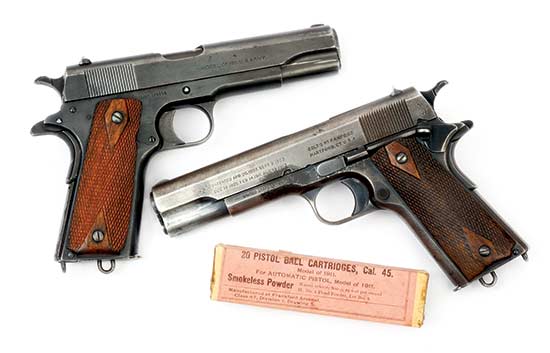The U.S. MODEL 1911 .45
World War 1 Handguns
When the United States entered World War I on April 6, 1917, the standard sidearm for the US Army, Navy and Marine Corps was the Model 1911 .45 Auto. The Colt Patent Firearms’ contract allowed these pistols to be made in government facilities after Colt had delivered the first 50,000. Incidentally, those first 1911s cost the government $14.25 each with two magazines. After that, magazines were 25 cents each.
The first ones arrived in government hands by April 1912 and within three years Colt had supplied over 72,500, so the government facility, Springfield Armory, tooled up to also manufacture them. That was a short-lived project, stopped in its tracks with the declaration of war. Logically the government felt Springfield Armory’s manufacturing potential should be devoted to making Model 1903 rifles instead of handguns so only about 26,000 Model 1911s were finished at the government facility. Colt received a $2 royalty for each of those.
Almost simultaneous with the United States’ declaration of war, Colt received a contract to supply another 500,000 1911s, and Remington-UMC got one for 150,000, with another 350,000 added to it shortly after. Military planners felt by the time World War I could be brought to a victorious conclusion American armed forces would need at least 2.5 million 1911s. To that end contracts were let out far and wide. Winchester Repeating Arms received one, as did Savage Arms, along with a newly formed outfit in Quebec, Canada named North American Arms. No one expected Germany’s army would collapse completely as it did in November 1918. No Model 1911s reached the completion stage except for Colt and Remington-UMC. And the latter factory’s total was a mere 22,000.
According to most research sources, if a Model 1911 .45 saw combat in World War I, it almost assuredly was made by Colt. The company’s manufacturing feat was astonishing. By the armistice on the 11th day of November 1918 Colt was finishing about 2,000 pistols each day. My gun collection holds two Model 1911s. The one made in 1917 has a serial number of 179XXX, while the other was made in 1918 and its number is 375XXX.
They were each alike in form if not in their exact markings. Barrels were 5″ in length, weight was 21/2 lbs. and grips were checked walnut panels. The sights were a tiny notch in a sight bar dovetailed to the slide’s rear and a tiny nub staked into the slide’s front. Zero was at 50 yards from the factory, and windage could be adjusted slightly with the rear sight. There was no manner in which elevation could be changed.
Magazine capacity was seven rounds and American military doctrine was the pistol be carried with an empty chamber until immediately before entering combat. Model 1911s had three safeties built into the design, including a grip safety, a small up/down lever on the frame’s left side and a half-cock notch in the hammer.
830 FPS?
Nowadays the common word is .45 Auto factory loads with 230-gr. FMJ “ball” bullets have a muzzle velocity of 830 fps. I’ve managed to land a couple of unopened boxes of US military loads dated 1915. Their boxes have velocity rated at 800 fps with a plus/minus of 25 fps. Canvas pouches holding two magazines were issued with each 1911 and its leather holster. Counting one magazine in the pistol a combat load was 21 rounds.
So who was issued 1911s? They went to officers, non-commissioned officers, enlisted men who were members of crew-served weapons teams, and every man in the still-active horse cavalry was issued one to go with his Model 1903 “Springfield.” Of course most historically minded readers already know the shortage of 1911s caused the government to purchase over 300,000 .45 ACP revolvers from Colt and S&W between 1917 and 1919. We’ll cover those later.
By the mid-1920s with the war emergency long over ordnance officers had enough changes dreamed up for the Model 1911 basic design. It became the Model 1911A1 (A1 = Alteration One). The military made it easy on themselves to discern between the two versions. If serial numbers were under 700,000 the pistol was a Model 1911. Over that and it was a Model 1911A1.
I’ll bet nobody back then ever dreamed those pistols would still be in at least some US military holsters even today!






